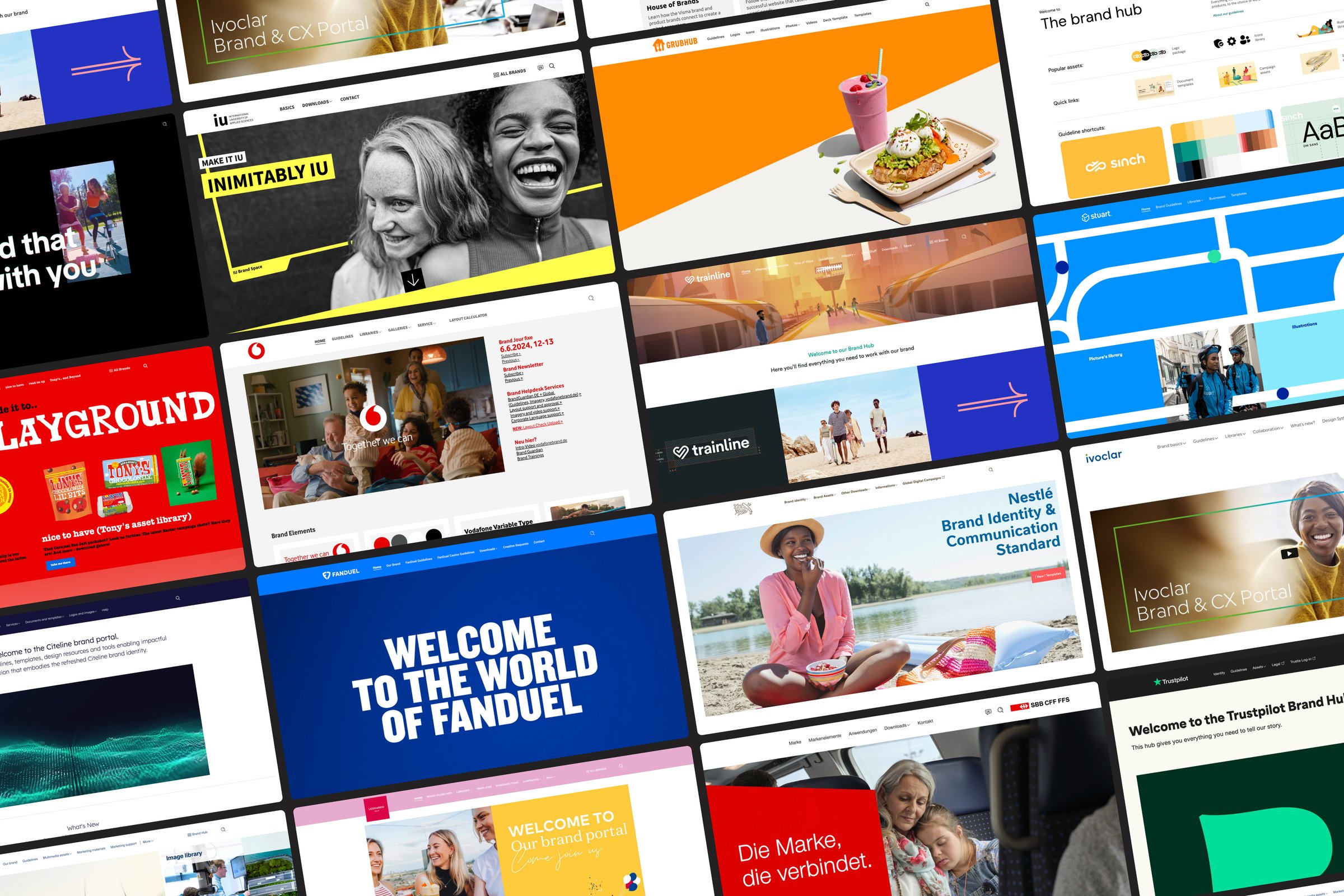Key takeaways
- Consistency is everything: Brand guidelines make it easy for every team to represent your brand the same way, helping you build recognition, trust, and credibility across every channel.
- Static files won’t cut it: As your brand evolves, PDF guidelines become outdated fast. A digital platform like Frontify keeps everything current, accessible, and easy to maintain.
- Clear, usable guidelines drive adoption: When your guidelines are practical, easy to navigate, and integrated with real brand assets, people actually use them, reducing off-brand content and design bottlenecks.
What are brand guidelines, and why does consistency matter now more than ever?
What are brand guidelines?
Your brand guide (whether you call it a brand book, manual, or style guide) documents and shares the rules, standards, and instructions for bringing your brand to life. These guidelines detail how your brand should look, act, and sound so everyone is on the same page and your brand always shows up consistently.
Think of it this way: if one team tweaks your logo color for a slide deck and another grabs an old version for social, things start to feel off. These small inconsistencies can chip away at your brand’s credibility over time. That’s where brand guidelines come in.
Why do brands need guidelines?
Brand guidelines turn your brand into something clear and usable, helping every team create consistent content and experiences, no matter their role. A consistent brand image can build trust, and guidelines make that consistency easy to achieve by:
- Boosting internal engagement: Everyone on your team can access and use your brand guidelines, not just your creative teams. This gives all employees a greater sense of ownership and the ability to create on-brand messages, designs, and customer experiences independently.
- Building brand recognition: Consistency across visual elements, voice, and behavior makes your brand look professional and helps your audience recognize your brand.
- Reducing off-brand materials: When teams know where to find the right assets and how to use them, they’re less likely to guess or go rogue, which means fewer one-off designs and more brand-aligned content.
Brand guidelines are where all your employees and external partners learn how to communicate to present an authentic brand to your customers. Tools like Frontify help brand guidelines do their job: aligning your entire company with your brand’s values, style, and messaging in one shared space.

The current state of brand guidelines
To build a strong, recognizable brand, you need everyone in your business to present a consistent brand identity to your customers and the market. But our State of Brand Ownership Report found that the worst offenders when creating off-brand materials were the teams you’d expect to be most invested: C-level executives and marketing departments.
But that’s not all: In the report, we found that 67% of respondents use creative guidelines that aren’t part of their official brand guidelines. This suggests that two-thirds of companies have guidelines that aren’t being used properly by their employees, potentially leading to inconsistent messages, confused customers, and weakened brand identity.
Developing comprehensive guidelines is a start. But companies also need to make the information accessible, update it regularly, and ensure that teams follow the guidelines whenever they create assets.

Transition to digital platforms
Many companies initially document their brand guidelines in PDFs. However, as the business grows and its brand evolves, employees find it hard to maintain and update the files to ensure everyone is working from the latest version. This situation can lead to version control issues, confusion, and off-brand content slipping through the cracks.
Because online brand guidelines are a centralized home for your brand, any changes are automatically reflected for all employees.
Key components of brand guidelines
There are a few common components that most companies include in their brand guidelines: brand core elements, correct logo usage, color palettes, visuals, and voice and tone.
Brand core
The brand core is the foundation on which a brand is built, encapsulating its heart and soul. It's not just about what a company does or sells but why it exists. This identity is pivotal in guiding decision-making, shaping brand experiences, and aligning with the audience's values and expectations. Let's delve into the components of the brand core.
- Brand values: These are the principles that define the ethical and operational backbone of your brand. Brand values guide behavior, decisions, and actions, ensuring that every aspect of the brand aligns with these foundational beliefs.
- Mission statement: This concise statement articulates the brand's purpose and reason for being — beyond making a profit. A well-crafted mission statement is inspirational and directs the brand's efforts toward a common goal.
- Vision statement: Whereas the mission statement focuses on the present, the vision statement looks to the future. It illustrates the brand's long-term aspirations, inspiring and motivating stakeholders to strive toward this shared dream.
A comprehensive brand core fosters a strong, enduring foundation for their brand identity. This foundation not only informs internal strategies and actions but also shapes how the brand is perceived and experienced by the outside world.
Logo use
Your guidelines should explain how to use your brand’s logos, covering the following elements:
- Color variations: Add the essential color variations, including full color, black, and white, and mention when to use each version.
- Logo formats: Include your full logo, text logo or wordmark, single-line, and square versions. Explain when to use which logo, with examples of each format in use.
Logo dos and don’ts
Along with your logo guidelines, include do’s and don’ts with examples. Do’s and don’ts help your teams visually and contextually understand the right way to use your logo. You can demonstrate correct logo use on different backgrounds (e.g., plain versus patterned) and channels (e.g., social media versus your website).
Uber’s brand guidelines comprise extensive guidance on logo use, formats, and placement. As an international company, it also explains how to localize its logo in languages that read right-to-left, which is an important consideration as your company scales into new markets.

Color palette
Brand colors help build brand recognition and make your company stand out. Covering your color palette in your guidelines is another way to bring consistency to your content and designs.
Add your brand’s color palette, including swatches that illustrate what each color looks like and color codes to use in their design tools. When you add color codes, list them in the relevant formats (like CMYK, HEX, and RGB) so your team uses the correct colors when designing for print and digital.
For example, Frontify’s brand guidelines include our primary, secondary, and gray-scale palettes, with examples showing the colors together. In addition, we made our color swatches downloadable so anyone accessing our guidelines can easily import our brand colors into their design applications. This download capability turns our guidelines from rules and instructions into a practical tool that empowers our employees to engage with our brand in their work.

Typography and imagery
A strong visual identity makes your content stand out in your customers’ social feeds, especially if you adopt a different style from your competitors. In the long term, your choice of image style and consistent visuals help build brand recognition.
Your guidelines should include guidance on using images to create designs that communicate your brand identity. Creating on-brand imagery can be challenging for non-designers, so the more guidance and examples you provide, the better. Here’s what your guidelines could cover:
- Image types (e.g., illustrations, photography, iconography, design elements, and patterns)
- Guidance on when to use stock images
- Image categories (e.g., product, industry, company, aspirational, and headshots)
- Preferred color schemes for images
- Approved typography, including fonts, font styles and weight (e.g., bold and italics), sizing, spacing, and more
- Any specific grammar conventions your brand follows (e.g., Oxford comma and capitalization rules)

Brand voice and tone
Brand voice and tone are often forgotten about in br, as many companies focus on the visual aspects of their brand identity. But how you write and speak is just as important for building recognition as your brand’s appearance.
Documenting your brand voice in your guidelines will ensure your written, audio, and video content achieves a consistent voice and style. Tone of voice guidelines help your team adopt a consistent brand voice, regardless of whether it’s a campaign from your marketing team or a ticket response from customer support.

Step-by-step: How to build and maintain brand guidelines
Whether you’re refining your brand guidelines or creating them from scratch, these steps can help you create standards that everyone can easily follow and adhere to.
1. Gather and align stakeholders on your brand core
Before documenting or updating anything, bring together leadership, brand, marketing, and creative teams to confirm your mission, vision, and values. It helps ensure everyone is aligned from the start so your brand guidelines reflect what your company actually stands for.
Use collaborative branding tools (like Frontify) to co-create or confirm your brand core elements with other team members before they become part of your guidelines.
2. Take inventory of your brand assets
Make sure all your brand assets are up to date and visually adhere to the new standards. Here’s what to do:
- Collect all current logo files, color codes, typefaces, and image libraries.
- Audit what’s outdated, missing, or off-brand.
- Upload all brand compliant assets to your DAM so they’re ready to link directly within your guidelines.
3. Build out the rules and resources for using your brand
Once all your key components and assets are aligned and accounted for, you can start building out the actual guidelines. Write simple instructions for how to use your brand elements, like where and how to use your logo, when to apply certain colors, or how to keep your tone consistent across channels.
Use real examples, create a list of do’s and don’ts, and provide editable templates for things like presentations or social posts. This helps teams apply the brand correctly without needing constant input from the design or marketing team.
4. Choose the format and platform for your guidelines
Decide where your brand guidelines will reside. Options include a dedicated brand portal or DAM, company intranet, or platforms like Google Workspace.
A comprehensive DAM like Frontify provides a centralized, easily accessible platform that all stakeholders can use to reference the guidelines effortlessly.
5. Implement and share guidelines
Once you’ve created your guidelines, you can share and implement them so they become the company standard.
We recommend using a digital and interactive brand platform for easy access and updates. This approach enhances user engagement and keeps your guidelines versatile and relevant.
Distribute your guidelines by giving all stakeholders access and providing training and support so that everyone gets the most out of the documentation.
6. Evaluate feedback and revise guidelines to overcome adoption challenges
Establish channels for stakeholders to suggest improvements or report inconsistencies, fostering collective ownership and adherence.
Collect feedback from users to identify areas for improvement. Use this input to revise and update your guidelines as needed, ensuring the information stays relevant and effective. This iterative process maintains your brand's identity.
The role of digital asset management (DAM) in enforcing brand guidelines
A DAM system keeps all your brand assets in one place, making it easy to update, share, and control what teams use. It streamlines brand guideline creation and keeps everyone on the same page about brand standards. Here’s how:
Interactive and flexible guidelines
Static guidelines age fast and they lack flexibility. Even a tiny edit means removing the old version, updating whatever file you have on hand, converting it to a PDF (or emailing a Word doc), and hoping everyone saves the new one. Then two days later, another small change pops up. The whole cycle starts again.
With a DAM like Frontify, updates are instant, so your team always has access to the latest version of your brand guidelines — no confusion, no outdated files.
Centralized storage and access
When people don’t know where to find brand-approved assets, they often create their own, leading to inconsistencies.
Centralized access keeps everyone aligned. DAM systems provide just that: easy access and management for your brand guidelines. Instead of juggling multiple folders, drives, and links, a DAM provides a single, organized hub, so teams spend less time looking for the “right” version or asking teammates to resend the guidelines.
Enhanced creativity and collaboration
Creative work is rarely a solo effort. Designers, marketers, and content creators all need to stay aligned to bring campaigns and brand experiences to life. Misalignment slows things down; feedback gets buried in email chains, outdated templates circulate, and last-minute changes create chaos.
Templates and shared tools, like DAMs, improve efficiency. When everyone works from the same starting point, it's easier to stay on brand and move faster. Creative, marketing, brand, and product teams can work in one shared space, removing silos and encouraging stronger brand ownership across departments.
Frontify helps you create easy-to-use brand guidelines
Some of the world’s leading companies use Frontify’s brand-building platform to house everything related to their brand, including guidelines. With Frontify’s Brand Guidelines, you ensure that everyone has access to up-to-date information that allows them to create, organize, and manage:
- Centralize your guidelines so everyone knows where to go to access the most recent version
- Customize your guidelines with no-code content elements to cover all use cases.
- Share guidelines with your internal team and external agencies and partners, collaborate on updates, and set access restrictions where necessary.
- Store and update your guidelines without needing to work with external graphic designers or agencies.
- Integrate Frontify with your existing tools, including Adobe, Figma, HubSpot, and more.
Companies with strong brand guidelines
Tony's Chocolonely
Tony’s Chocolonely has a bold, unique logo that helps with brand recognition. To build on that awareness, they sought out Frontify to create, host, and maintain their brand guidelines.
Tony’s brand guidelines are strong because they’re bold, clear, and easy to use. The personality of the brand comes through in every element — from the bright visuals to the playful tone — while the structure makes it easy for teams to apply the brand consistently across every channel.

Leonardo Hotels
Leonardo Hotels has a large global presence and needs to centralize their branding so every employee can easily adhere to the same set of brand standards, no matter what region they’re in.
By using Frontify's platform, they have created a unified brand portal that integrates guidelines, a DAM system, and templates. The centralized system has led to significant time and resource savings, with over 200 publications created monthly and more than 1,000 hours saved annually.

Ready to build your brand guidelines? Request a demo to learn more about Frontify, and see how easy it is to keep your brand consistent.



